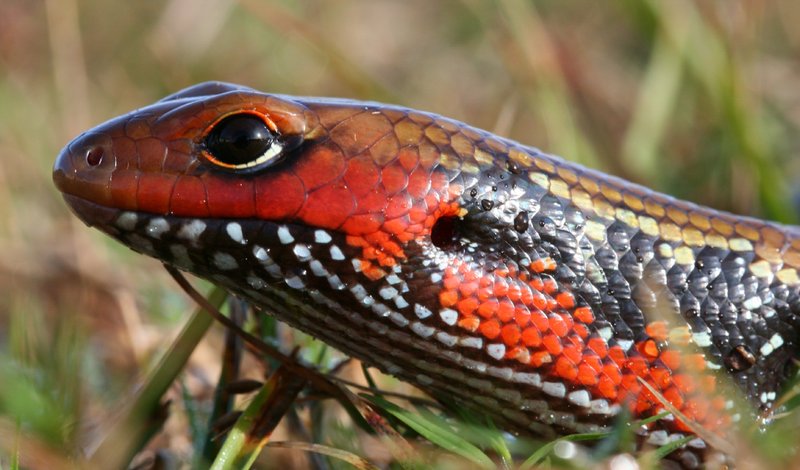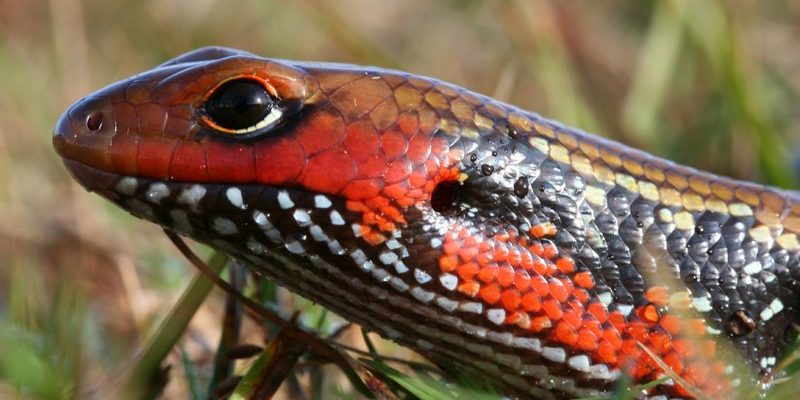
So, let’s dive into the lively world of fire skinks! In this article, we’ll bust some common myths and uncover the facts about these captivating reptiles. Whether you’re thinking about keeping one as a pet or just want to learn more, we’ll explore everything you need to know about these mesmerizing lizards.
What Exactly is a Fire Skink?
Fire skinks (Gomphtophis spp.) are a species of lizard native to parts of Africa, particularly in regions like Madagascar and the surrounding areas. These reptiles are easily recognizable thanks to their dazzling patterns, which typically include bright orange, red, or yellow stripes against a dark background. Imagine a sunset captured in a tiny lizard—it’s hard not to be drawn in by their beauty!
Now, you might wonder what makes fire skinks different from other lizards. Well, they have a unique behavior. They’re known for being secretive and often hide among rocks and foliage in their natural habitat. They love to burrow and can be a bit elusive, which adds to their charm. If you’re lucky enough to spot one in the wild, it’s like finding a rare treasure in the underbrush.
Myth 1: Fire Skinks are Super Aggressive
You might have heard that fire skinks are known for their aggression. Honestly, that’s a common myth! While they might look fierce with their beautiful colors, fire skinks are generally quite calm when handled correctly. They prefer to avoid confrontation and will usually flee rather than fight.
Let me explain. Like many reptiles, fire skinks can get stressed if they feel threatened. When kept as pets, it’s essential to give them a safe space where they can retreat when feeling uneasy. If you handle them gently and allow them to get used to you, they can become quite friendly. Just remember, respect their space, and they’ll reward you with their trust.
Myth 2: They’re Too Hard to Care For
Another myth is that fire skinks require complex care routines that are beyond the abilities of a beginner. Here’s the thing: while they do have specific needs, they are not that difficult to care for if you follow some basic guidelines.
For example, a suitable habitat for a fire skink should include a warm environment (between 75°F to 90°F), ample hiding spots, and a substrate that allows for burrowing. A simple setup can work wonders without turning your life upside down.
Additionally, their diet primarily consists of insects, which can be easily sourced at pet stores. With a little research and preparation, you can create a thriving environment for your fire skink that meets both its needs and your comfort level.
Fact: Fire Skinks Have Unique Social Behaviors
One interesting fact about fire skinks is their social behavior. While they can be solitary, they often tolerate others of their kind when appropriately introduced. This means you might be able to keep a small group together, as long as they have enough space to avoid conflicts.
Imagine living in an apartment with your buddies. If it’s too cramped, you might get annoyed. But if everyone has their own space, it’s a great time! Similarly, fire skinks thrive in environments where they feel safe and have room to roam. So, if you’re considering a small community setup, just make sure to monitor them closely to prevent any territorial disputes.
Myth 3: Fire Skinks are Always Active
You might think that because fire skinks have a reputation for being vibrant and lively, they must be constantly on the move. Not necessarily! These little guys enjoy basking and can spend a fair amount of their time relaxing or resting among their hideouts.
In fact, they have a natural rhythm where they might be active during certain times of the day—often in the early morning or late evening when the temperature is just right. You might catch them stretching out on a warm rock, soaking up the sun like a lazy beachgoer. Understanding their behavior helps you appreciate these reptiles more and sets realistic expectations for watching them.
Fact: Their Lifespan Can Surprise You
Here’s a fun fact—fire skinks can live quite a long time with proper care! Often, they can live anywhere from 10 to 15 years in captivity. That’s longer than you might expect for a lizard. So, if you’re thinking about bringing one home, it’s essential to be prepared for a long-term commitment.
Like any pet, they thrive on good husbandry and attention. Providing a clean habitat, proper diet, and regular vet check-ups can significantly influence their lifespan. Just picture it: a decade of watching your fire skink grow and thrive can be a rewarding experience!
Choosing the Right Fire Skink
If you’re considering a fire skink as a pet, you might be wondering how to choose the right one. First off, you should look for a reputable breeder or pet store that provides clear information about the skink’s health history. This helps ensure that you’re getting a healthy animal, which is crucial for a long life together.
Once you find a potential pet, check for signs of good health. Look for bright eyes, clear skin, and an alert demeanor. If the skink seems lethargic or unresponsive, it might not be the right fit for your home. Remember, it’s like finding a good friend; you want someone lively and eager to hang out!
So, there you have it! Fire skinks are fascinating reptiles that come with a mix of myths and realities. They aren’t the aggressive monsters some might think, and their care is manageable with the right knowledge. Plus, their social behaviors and the potential for a long lifespan make them worthy companions.
Whether you’re simply curious about these colorful little creatures or considering one as a pet, understanding their needs and personalities is key. With a bit of research and a lot of love, you can create a happy environment for your fire skink, allowing you both to enjoy the beauty of this unique lizard together. So, do you think you might be ready to welcome one into your life?

